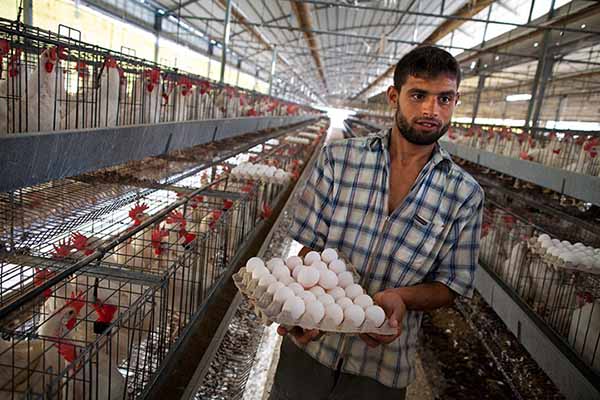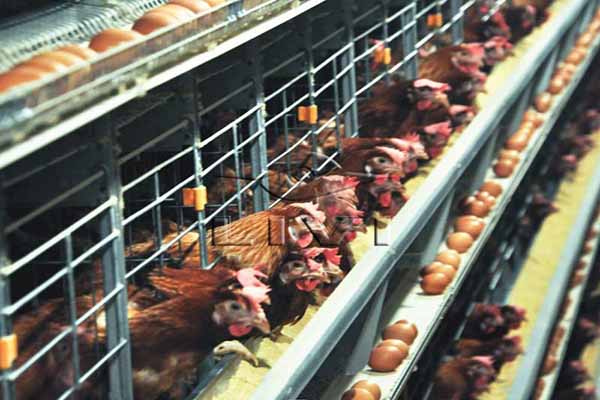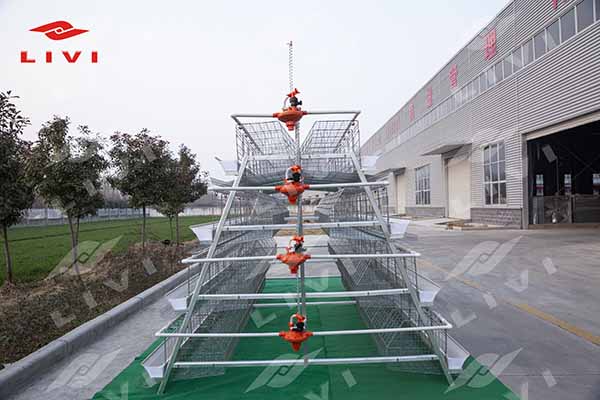Poultry farming, especially egg production, has become one of the most vital segments of agriculture worldwide. As the global demand for eggs continues to rise, large-scale egg production operations—like a 10,000 layers poultry farm—are crucial to meeting this demand efficiently and sustainably. In this article, we will explore the potential egg production of a 10000 layers poultry farm, the impact of automation on egg collection and loss reduction, and how specialized equipment, such as Livi Chicken raising equipment, can help farmers optimize their egg production business.



How Many Eggs You Can Get From A 10000 Layers Poultry Farm
1. Understanding Egg Production in a 10000 Layers Poultry Farm
What is a Layer Poultry Farm?
A layer poultry farm is designed specifically for the purpose of egg production. The term “layer” refers to chickens that are bred for high egg yield, rather than meat production. Unlike broilers, which are raised for meat, layer hens are selected for their ability to lay eggs consistently. These hens typically begin laying eggs at around 18-20 weeks of age and can continue to produce eggs for 12-18 months, depending on their breed and management.
The most common breeds used in commercial egg production are Leghorns, Rhode Island Reds, and ISA Browns, among others. These birds are specially bred for their laying ability, with some high-production breeds capable of laying more than 300 eggs per year under optimal conditions.
Average Egg Production Per Hen
A healthy layer hen typically lays one egg per day, although this can fluctuate based on factors such as breed, age, feed quality, and environmental conditions. Commercial farms strive to maintain conditions that maximize egg production, including optimizing feed, lighting, and temperature control.
For a 10000 layers poultry farm, egg production can be easily estimated using average daily egg output per hen. In ideal conditions, where each hen lays one egg per day, the farm could produce up to 10,000 eggs per day.
2. Calculating Daily and Monthly Egg Production
Daily Egg Production
At the heart of a 10000 layers poultry farm is its daily egg production capacity. With an average of one egg per hen per day, a farm with 10,000 layers will produce:
- 10,000 eggs per day.
However, the number of eggs produced can be affected by several factors, such as seasonal changes, the health of the flock, and the age of the birds. It’s also important to note that not every hen will lay an egg every day—some hens may skip a day or lay less frequently, particularly as they age. Therefore, a realistic figure for daily production might be slightly lower than the theoretical maximum of 10,000 eggs per day.
Monthly Egg Production
To estimate the monthly output of a 10,000 layers poultry farm, we multiply the daily output by the number of days in a month. Assuming the farm operates at full capacity:
- 10,000 eggs/day × 30 days = 300,000 eggs per month.
This means that a 10000 layers poultry farm could produce approximately 300,000 eggs per month under optimal conditions. Again, this figure could fluctuate based on external factors such as health, nutrition, and farm management.



Egg Production Business For 10000 Layers
3. Accounting for Egg Loss: Breakage and Mortality Rates
In any large-scale egg production operation, some level of egg loss is inevitable. These losses can come in the form of cracked or broken eggs during handling, as well as losses due to mortality or other unforeseen circumstances.
Breakage Rate and Egg Handling
Egg breakage is one of the most common types of loss in poultry farming, and it typically occurs during the collection, handling, and packaging stages. If eggs are mishandled, their shells can crack or break, rendering them unfit for sale. This issue is particularly prevalent in manual egg collection processes, where human error or rough handling can lead to breakage.
On a 10,000 layers poultry farm, where eggs are collected daily from thousands of hens, it’s important to minimize breakage. The use of automated egg collection systems—such as those provided by Livi Chicken raising equipment—can significantly reduce the breakage rate. Automated systems ensure that eggs are gently collected, reducing the physical stress on the eggs and minimizing the risk of damage.
If you want to start your chicken business, please contact us.
Leave us a message or contact us via WhatsApp: +86 17344898347.
With high-quality automation, the breakage rate can be reduced to as low as 0.5%, a figure that is much lower than what is typical in manual collection processes.
Calculating Breakage Loss
Let’s assume that a 10,000 layers poultry farm produces 10,000 eggs per day, with a breakage rate of 0.5%. The number of broken eggs can be calculated as follows:
- 10,000 eggs/day × 0.5% = 50 broken eggs per day.
Over the course of a month (30 days), the total number of broken eggs would be:
- 50 broken eggs/day × 30 days = 1,500 broken eggs per month.
Adjusted Total Production
After accounting for breakage, the adjusted total number of eggs that can be sold or consumed would be:
- Daily: 10,000 eggs – 50 broken eggs = 9,950 eggs/day.
- Monthly: 300,000 eggs – 1,500 broken eggs = 298,500 eggs/month.
Thus, with a breakage rate of 0.5%, the 10000 layers poultry farm would yield 298,500 eggs per month that are saleable and free from damage.



A 10000 Layers Chicken Farm
4. Increasing Egg Production: Ways to Boost Your Hens’ Productivity
While a 10,000 layers poultry farm can produce significant quantities of eggs, there are always ways to improve the production rate and make the most out of each hen. Here are several strategies to boost egg production:
1. Optimize Nutrition and Feeding
The quality and consistency of feed are critical to the overall egg-laying performance of hens. A balanced diet rich in protein, vitamins, and minerals ensures that hens have the energy they need to lay eggs efficiently. A 10,000 layers poultry farm should invest in high-quality commercial feed or develop a custom feed mix to meet the nutritional needs of the flock.
- Protein: Adequate protein in the diet is essential for egg production. A lack of protein can result in fewer eggs being laid, or the eggs may be of poor quality.
- Calcium: Calcium is crucial for shell formation. Insufficient calcium can lead to thin-shelled eggs or even egg breakage. Offering a calcium supplement like oyster shells can help prevent these issues.
- Omega-3 and Antioxidants: Supplementing the feed with omega-3 fatty acids and antioxidants can improve egg quality, including enhancing shell strength and yolk color.
2. Lighting Control
Layer hens are highly sensitive to light, and the amount of light they receive directly impacts their egg-laying behavior. During the natural daylight cycle, hens typically lay more eggs during the longer daylight months. However, by manipulating light exposure, farmers can stimulate egg production year-round.
- Artificial Lighting: Adding artificial lighting to the chicken house can extend the photoperiod and encourage hens to lay more eggs. In general, hens need about 16 hours of light per day to remain productive. However, it’s essential to maintain a proper light-dark cycle to avoid overstressing the birds.
3. Temperature and Environmental Control
Environmental factors such as temperature, humidity, and ventilation can significantly affect egg production. Hens are most productive when they are comfortable, and extreme conditions can cause stress, reduce feed intake, and negatively impact egg production.
- Temperature: Hens prefer temperatures between 18-24°C (65-75°F) for optimal egg production. When it gets too hot or too cold, their laying frequency can drop.
- Ventilation: Proper airflow helps regulate the temperature and humidity levels, preventing conditions like heat stress or excessive moisture in the poultry house. Fresh air and good ventilation ensure hens stay healthy and productive.
4. Health and Biosecurity Management
Regular veterinary check-ups, vaccinations, and strict biosecurity measures are essential to prevent disease outbreaks that can lower egg production. Ensuring that hens remain disease-free and comfortable will help maintain high levels of egg production.
- Disease Prevention: Vaccinations and biosecurity measures reduce the risk of infectious diseases, which can affect egg-laying rates and overall productivity.
- Parasite Control: Regular deworming and pest control can help prevent issues that might affect the hens’ health and their egg-laying ability.
5. Stress Reduction
Stress is a major factor that negatively impacts egg production in laying hens. Stress can be caused by overcrowding, poor management, or external disturbances. Maintaining a calm, comfortable environment for the hens is crucial to maximizing egg production.
- Space: Ensure that the hens have enough space to move around comfortably. Overcrowded conditions lead to competition for food and nesting areas, which can cause stress and reduce laying frequency.
- Behavioral Enrichment: Providing hens with opportunities to engage in natural behaviors like scratching and dust bathing can reduce stress and improve overall well-being.
By implementing these strategies, a 10,000 layers poultry farm can increase its egg production and ensure that hens remain healthy and productive throughout their laying cycle.



5. Enhancing Egg Production Efficiency with Automated Systems
The Impact of Automation on Egg Collection and Loss Reduction
One of the most significant challenges in large-scale egg production is ensuring that the eggs are collected efficiently and without damage. Traditionally, manual egg collection involved workers walking through the chicken house to gather eggs by hand, a labor-intensive and error-prone process. Eggs would often be damaged by rough handling, leading to higher breakage rates and reduced profitability.
Automated egg collection systems, such as those offered by Livi Chicken raising equipment, are designed to streamline this process and ensure that eggs are collected gently and efficiently. These systems use conveyors, rollers, and other automated mechanisms to gently move the eggs from the nesting areas to collection points, minimizing the risk of breakage.
The main benefits of Livi Chicken raising equipment include:
- Reduced breakage rates: Automated systems reduce the chances of human error during egg collection, ensuring that eggs are handled delicately and minimizing cracks or damage.
- Increased efficiency: Automation speeds up the collection process, reducing the need for manual labor and improving the overall efficiency of the farm.
- Improved hygiene: Automated systems help maintain a clean environment by reducing the need for workers to frequently enter the poultry house, which can introduce contaminants.
- Lower labor costs: By reducing the reliance on manual labor for egg collection, automated systems can help reduce operational costs in the long run.
By incorporating Livi Chicken raising equipment into their operations, poultry farmers can significantly increase their efficiency, reduce losses, and ultimately enhance their egg production business.
6. Starting and Scaling an Egg Production Business
Key Considerations for Scaling Up to a Egg Production Business for 10000 Layers
Starting an egg production business for 10000 layers requires careful planning and significant investment. Key factors to consider include:
- Farm infrastructure: Setting up the right housing, feed systems, and environmental controls is essential for maintaining the health of the birds and optimizing egg production.
- Feed and nutrition: A balanced and nutritious diet is crucial for maintaining high production rates. The quality of feed affects the health and productivity of the hens.
- Lighting and temperature control: Proper lighting and temperature management are essential for stimulating egg-laying behavior. Layer hens require approximately 16 hours of light per day to maintain optimal egg production.
- Labor: Managing a farm of 10,000 layers will require a team of workers, especially during the early stages when manual processes may still be involved. However, automation can help reduce labor costs over time.



Start You Poultry Farming Business, Leave Us A Message
7. How Livi’s Solutions Can Support Your Poultry Farm
For farmers looking to scale up their egg production business, Livi Chicken raising equipment offers a range of solutions that can simplify the process and improve overall efficiency. From automated egg collection systems to advanced feeding and ventilation equipment, Livi provides comprehensive solutions to help farmers run their operations smoothly.
Livi’s equipment can help farmers:
- Set up automated systems: Livi’s automated egg collection, feeding, and watering systems can be installed to ensure that the farm runs efficiently with minimal human intervention.
- Reduce losses: With low breakage rates and automated processes, Livi’s systems help reduce the number of damaged eggs, ensuring higher yields and profitability.
- Scale quickly and efficiently: Livi’s equipment is designed to handle large-scale operations, allowing farmers to scale up their egg production business without compromising on quality or efficiency.
8. Conclusion
The potential for egg production in a 10,000 layers poultry farm is substantial, with an estimated 10,000 eggs per day or 300,000 eggs per month under optimal conditions. However, factors such as breakage and handling losses must be accounted for in any large-scale operation. By integrating Livi Chicken raising equipment into their systems, farmers can significantly reduce breakage rates, improve efficiency, and enhance the overall productivity of their egg production business.
With the right equipment, a 10,000 layers poultry farm can achieve high output while minimizing waste, ensuring a profitable and sustainable business in the growing global egg market.
If you want to start your chicken business, please contact us.
Leave us a message or contact us via WhatsApp: +86 17344898347.












